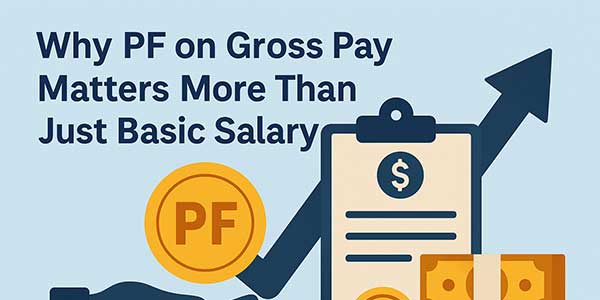
Every paycheck tells a story of sweat, skill, and strategy. Yet, the taxman always wants a cut. While paying taxes is a citizen’s duty, smart savers know the art of tax planning isn’t about evasion, but wise, well-timed decisions. Enter the world of smart investment declarations — where your money works double-time: growing your wealth while trimming your tax outgo.
This book reveals smart, lesser-known, and proven techniques for making your declarations confidently and efficiently, cutting that income tax to size.
Table of Contents
1.) The Power Of Planning: Why Declarations Matter:
Before diving into the investment basket, let’s understand the golden rule of tax saving: plan early, declare wisely. Every salaried individual has to submit investment declarations to their employer, usually at the start of the financial year. Failing to declare can lead to higher monthly TDS (Tax Deducted at Source) and a smaller paycheck.
Declaring doesn’t imply you must invest now, but it provides you with space to breathe until March to implement such investments. You can think of it as booking your tax-saving rights before the fiscal door shuts.
2.) Leveraging The 80C Galaxy – Your First Line Of Defence:
Your magic wand is Section 80C of the Income Tax Act. It provides a deduction of as much as ₹1.5 lakh a year, and clever taxpayers learn to leverage this treasure chest.
Top Contenders in 80C:
- Life Insurance Premiums – Protection combined with deduction.
- Employee Provident Fund (EPF) – Your employer might already be contributing, but so is your share.
- Public Provident Fund (PPF) – Long-term and tax-exempt returns.
- National Savings Certificate (NSC) – Small savings with guaranteed returns.
- 5-Year Fixed Deposits – Bank FDs with tax-saving tags.
- Children’s Tuition Fees – A family-friendly deduction.
- Home Loan Principal – That EMIs do more than just clearing your loan.
Pro tip: If you’re unsure what to pick, diversify. Split the ₹1.5 lakh across safe and growth-oriented instruments.
3.) Go Beyond 80C – Explore The Outer Rings Of Tax Savings:
Whereas 80C hogges all the attention, astute investors look deeper into the tax law to find more deduction gemstones:
Section 80D – Health is Wealth (and a Tax Saver too!):
- Avail deductions up to ₹25,000 for premiums paid towards health insurance for self, spouse, and children.
- An extra ₹25,000–₹50,000 can be claimed for insuring parents (based on age).
This is not just a tax advantage — it’s future-proofing your medical bills.
Section 80E – The Education Edge:
Have a loan for education? The interest you pay is eligible for deduction, with no limit. You can enjoy this facility for 8 years of assessment from the year you start paying the loan.
Section 24(b) – The Home Sweet Home Advantage:
Have you borrowed a home loan? You can claim a deduction of ₹2 lakh on the interest part under this section.
NPS Contribution – Section 80CCD(1B):
Need an additional ₹50,000 tax advantage? National Pension Scheme contributions are eligible under this bonus deduction, over and above 80C.
Fast Insight: Consider these sections your multi-layered armour against brutal tax punches. Plan to use them strategically according to life stage — health plans in mid-career, education loan in early earners, and NPS in retirement planners.
4.) Rental Income Hacks – Maximise Your Property:
If you’re getting rent from tenants or residing in a rented house, there’s scope for manoeuvring cleverly:
House Rent Allowance (HRA):
- If you reside in a rented house, you can claim HRA deductions. The amount varies with rent paid, salary, and city of residence.
- Even if your salary structure doesn’t include HRA, you can claim a deduction under Section 80GG if you’re paying rent.
HRA Calculation Formula:
Least of:
- Actual HRA received
- 50% of salary (metro) / 40% (non-metro)
- Rent received minus 10% of income
- Standard Deduction on Rental Income
Property owners are allowed a standard deduction of 30% on rental income under the head, without any bills!
5.) Declaration Dos and Don’ts – Avoid These Rookie Mistakes:
Declaring investments is not all about writing down things. It’s about accuracy, legitimacy, and timing.
Do:
- Declare early to avoid excess TDS.
- Retention of digital or physical evidence of investments.
- Match actual investments with announced amounts at financial year-end.
Seek a tax advisor for complicated cases such as capital gains or multiple properties.
Don’t:
- Exaggerate declarations — HR may request proof afterwards.
- Wait until March for lump-sum investments. Smuggle them throughout the year.
- Don’t ignore Form 12BB — it’s your official investment statement.
🛡Protect Your Salary: Inaccurate or unverified declarations can result in additional tax deductions, reduced take-home salary, and a painful April refund hunt.

6.) Digital Tools: Your Tax Saving Sidekick:
These days, making declarations doesn’t involve writing on pieces of paper. Most employers have digital portals where you can:
- Make declarations.
- Upload proofs of investments.
- Monitor real-time changes in tax liability.
Use spreadsheet trackers or budgeting apps to chart your annual investments. These programs can send reminders of maturity dates, lock-in periods, and diversification of the portfolio.
7.) Bonus Booster: Tax-Free Income Ideas:
This is where clever savers become money magicians — by making untaxed income!
- Tax-Free Bonds
Government-backed institutions issue these, paying regular interest, without increasing your taxable income.
- Maturity from PPF
All returns received or withdrawn at maturity from PPF are tax-free.
- Long-Term Capital Gains (LTCG) Exemptions
If you’ve had specific assets such as equity shares or mutual funds for more than a year, you can enjoy partial tax relief.
8.) Salary Structuring: The Secret Sauce for High Earners:
If you’re in a higher income tax slab, structuring your salary effectively can help minimise your tax liability considerably.
Elements You Can Use:
- Meal coupons or food card benefits
- Leave travel allowance (LTA)
- Telephone reimbursements
- Work-from-home expense reimbursement
- Performance-linked bonuses (taxed only when received)
Discuss with your HR the amount of flexibility possible in your salary structure. These elements can lower your taxable salary without lowering your net income.
9.) Wrapping Up: Be Proactive, Not Reactive:
The financial year doesn’t conclude in March, but your opportunity to save taxes does.
Final Tips:
- Begin early (ideally in April).
- Combine safety, returns, and deductions.
- Make use of digital tools and monitor declarations.
- Provide investment proofs on time — typically by January or February.
Each rupee of tax you save today can become tomorrow’s comfort, vacations, investments, and dreams come true.
10.) Conclusion: Accumulate Wealth, Not Anxiety:
Tax filings may be mundane, but they are a game of chess, with the greatest move being forward vision. Be the player who is ahead of the game, not the one rushing in March.
Say smartly, spend wisely, and make your money work doubly — enrich your future and reduce your tax.

 About the Author:
About the Author:
















Great insights! This article provides valuable information and helpful tips. I appreciate the clear explanation and practical advice. Looking forward to more content like this!
Welcome here and thanks for reading our article and sharing your view. This will be very helpful to us to let us motivate to provide you with more awesome and valuable content from a different mind. Thanks again.